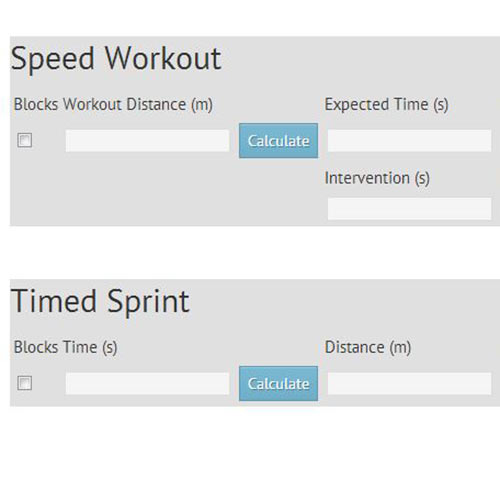Overview
The sprint calculator is divided into three major components that include a Speed Workout, Timed Sprint, and Improvement Predictor. Each of these calculations are described in the sections below. To use the calculator visit the page at Sprint Calculator.
What it Does
The Sprint Calculator uses two timed trials of an athlete, a short sprint and a long sprint, to compute the expected times for all other sprint sprint distances for that athlete.
Conventions
Units
All distances are in meters, times are in seconds, and speeds are in meters per second.
Fly Speed
All of the speeds are reported as fly speeds. If blocks were used for a sprint the Blocks check box should be selected. The Block Conversion factor is subtracted from the sprint time when calculating the fly speed.
Block Conversion
The Block Conversion is the time in seconds that is used to convert a block sprint to a fly sprint. For example, if the Block Conversion factor is set to 1.17 seconds and an athlete runs a 60 meter sprint with blocks in 8.17 seconds, then the fly sprint time is (8.17 seconds – 1.17 seconds) or 7.00 seconds. The Fly Speed is then calculated as (60 meters / 7.00 seconds) or 8.57 m/s. If an athlete ran a 60 meter fly sprint in 8.17 seconds, then the Blocks check box would not be selected and the Block Conversion would not be done. The Fly Speed would be (60 meters / 8.17 seconds) or 7.34 m/s.
Intervention
The Intervention number is a percentage and is used by the Speed Workout computation. For example, if the Intervention is set to 5% and an athlete is expected to run a 30 meter fly sprint in 3.50 seconds, then the Intervention time for that athlete is (3.50 seconds * 1.05) or 3.66 seconds. The default value for Intervention is 5% and can be changed in Preferences.
Athlete Data
The athlete data is used as baseline input for all the other computations. The athlete data includes a time and distance for a short sprint and a long sprint. The recommended distance for the short sprint is between 10 and 40 meters, and the recommended distance for the long sprint is between 150 and 400 meters. If either or both of the sprints use blocks, then the Blocks check box should be checked.
Clicking the Example button will enter sample data into all the Athlete Data fields as well as sample input data for the three computations Speed Workout, Timed Sprint, and Improvement Predictor.
Clicking the Reset button will clear all the data fields and set the Preferences back to the default values.
Speed Workout
The Speed Workout computation allows the coach to plan a workout for any distance based on the short and long sprints in the Athlete Data. For example, the Athlete Data may include times for 30 meter and 300 meter tests, and today’s workout could be a 60 meter fly sprint. The Speed Workout computation will compute both the time the athlete should be able to run at the workout as well as an intervention time based on the Intervention percentage set in the Preferences.
Timed Sprint
The Timed Sprint computation is similar to the Speed Workout except rather than plan a workout based on distance the workout is based on time. This computation is particularly useful when training a group of athletes with different levels of performance. For example, if a group of high school athletes all run a 300 meter workout, the times can vary widely and the slower athletes will hit different energy systems compared to the faster athletes. In the Timed Sprint computation the workout is based on a time (e.g. 25 seconds). All the athletes will run for the same amount of time; the faster athletes will run farther than the slower athletes.
Improvement Predictor
The Improvement Predictor has a number of uses. First, as an athlete improves in the short distances, some coaches may not want to perform a long sprint test just to update the Athlete Data. The Improvement Predictor can estimate a the long sprint time based on the new short sprint time.
Second, the Improvement Predictor can show what time will be needed at one sprint distance to achieve a time at another sprint distance. For example, suppose a female high school athlete currently has a 30 meter fly time of 3.52 seconds and a 300 meter fly time of 40.0 seconds. Suppose the athlete needs a 400 block sprint of 56.3 seconds to qualify for the state meet. Assuming the speed curve remains more or less “parallel”, the athlete will need an improved 30 meter fly time of 3.47 seconds to run a 400 sprint in 56.3 seconds.
Preferences
The calculator includes two preferences which are the Block Conversion and Intervention. The Block Conversion is a time in seconds and the default value is 1.17 seconds. The Intervention is a percentage and the default value is 5%. Each of these preference may be changed to some of other value. Clicking the Preferences->Default button will change these preferences back to the original default values.
Credits
The Sprint Calculator was written by Christopher Glaeser. Special thanks to Dr. Peter Weyand for insightful discussions and to Coach Ken Jakalkski for testing various versions of the calculator.
Please share this application so others may benefit.
[mashshare]Comments, Questions, Feedback
If you have comments, questions, or feedback about the Sprint Calculator please include them in the comment section.




im from south africa and have a hand full of really good prospects for the future but i lack that intens speed session workout… i really need help as i feel that we worked hard for the whole year next year i need something fresh …. its high school boys and they all provincial sprinters …. any help pls …. i been teaching them to keep accelerating very simuliar to carl lewis . not eeaching ur top speed round about the 60 m line but more at about the 80-90 m … and it worked brilliantly but i still need that explosive speed session …. pls help
Hey how are you doing. I am a 31 year old and I recently took up sprint training because I plan to enter a track meet in 11 days time for fun. The event I am interested in is 100 meters. However I ran 4.25 seconds at 30 meters on a wet and moderately muddy grass track with no starting blocks and a 12.50 seconds at the 100m with no starting blocks as well using a stopwatch. Is there a way to calculate what my time would have really been if I was running on a real synthetic track with starting blocks and electrical timing for both the 30m and the 100m? What do I have to do to improve my timing as well?
I am not aware of any calculator that can convert a wet, muddy, grass time to a modern track time. However, in 11 days, you will know the answer. Good luck.
Is there a difference in the Freelap timing system and hand time. Like FAT is .24 seconds slower than hand time.
Thanks
Kyle
Kyle, it depends on the drill you are timing and the skill of the coach, but yes, there is typically a difference. For example, when hand timing the 40 yard dash on first movement, you must add the coach’s reaction time which varies from coach to coach. When hand timing a 30 m fly, a skilled coach can be pretty close with practice and standing in a location that minimizes parallax.
So if you had to guess, would you have a time that it would be off?
Thank you for all your hard work and sharing your knowledge. I really appreciate your sharing.
Cheers
Michael Smith
What exactly is the Intervention and what is it’s practical application?
The purpose of the intervention, basically, is that it indicates a range at which the athlete is no longer putting out the proper power to maintain true max speed for them. I know I’m somewhat explaining that incorrectly. It does, however, he’ll to individualize sprint training. The “pace” times aren’t random but suited for the person.